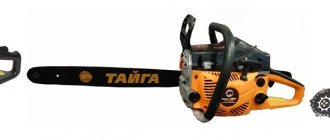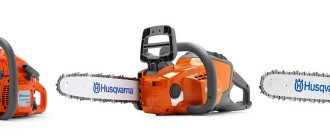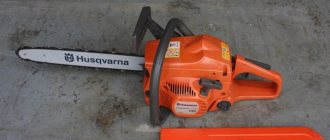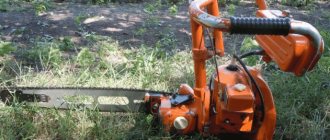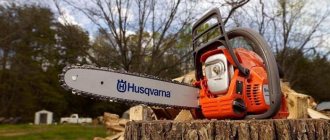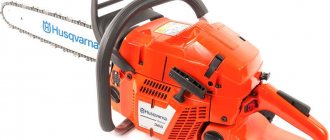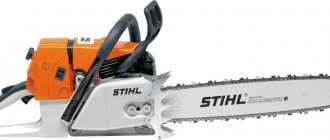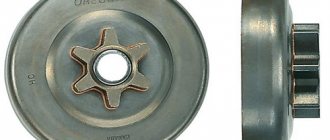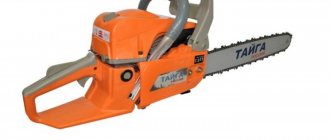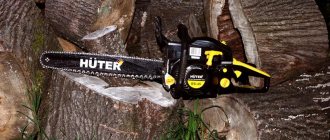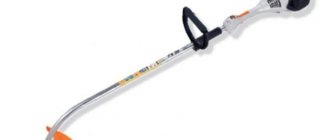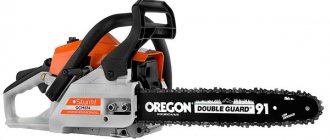Signs of a faulty chainsaw.
Whatever source of heat warms us from the bitter cold, there is still nothing warmer than the bright Sun or a flaming fire that unites interlocutors, trying to tell us about something interesting through the crackling of the wood burning in it.
Yes, it is easy to get firewood in the forest. They are everywhere. But in order not to run into the forest and look for “twelve months” and ask to warm up by their fire, it is better to prepare firewood for the winter in advance and then, during a severe snowstorm, enjoy aromatic tea with jam and bagels in the house by a warm stove. How can we prepare that very firewood if the previously “friendly” chainsaw already refuses to be friends with us “citing a bunch of sores”?
Here is one example of a failure of the Taiga-245 chainsaw.
The chainsaw was purchased in 2003 and over the following years it served its purpose without fail. Every year, with its help, eight to twelve stackers of firewood were prepared. There were minor operational problems due to inappropriate gasoline. Over the entire ten years of its existence, only the starter cord, compression rings and spark plug were replaced.
In the last harvesting season, Taiga flatly refused to work. It started with great difficulty. There were no high engine speeds or idling. The power was not enough to cut even small round timber. It could stall at any moment and then not start at all, as if screaming: “It’s not my fault!” I can not take it anymore!'
What to do? Where to start repairing a chainsaw? We decided to start researching and observing her work in order to identify all the “sores” based on the symptoms.
Determining the cause of the non-working condition of the Taiga-245 chainsaw.
Two days of fiddling with the chainsaw was enough to diagnose it, and the time for repair came in the evening of the second day. We have identified two reasons for the inoperability of the Taiga-245 chainsaw .
- 1. The segment key of the magneto flywheel is broken.
We were a little upset. We made a new one. The source of the material was an old support wheel pin from a ZAZIK.
- The workpiece was cut to the required size.
- Without effort, constantly cooling in water, they ground it on an emery stone.
- Adjusted to the required size.
- We polished it with a sharpening stone and installed the resulting key in its place.
How was the broken segment key determined? When trying to start the engine, we noticed a kickback, indicating early ignition timing. We also noticed rare flashes in the muffler or carburetor.
- 2. The volume of fuel in the working chamber of the carburetor does not correspond to the amount of fuel consumed by the engine in all modes.
The source of the cause was the spring of the rocker arm, which opens the fuel valve at the moment of discharge and the deformation of the lever of the rocker arm itself.
In our opinion, the constant compression of the spring during operation of the chainsaw led to its slight deformation, but sufficient to change the operation of the carburetor and thereby disrupt the operation of the chainsaw engine.
The rocker arm also turned out to be slightly bent and, when fully pressed by the diaphragm pusher, it could not fully open the fuel valve. The engine did not have enough fuel under load. But because of the soft spring, when trying to start the engine, there was so much fuel that the spark plug was flooded and, naturally, starting the engine was the most stressful and time-consuming process.
- We selected a new spring of the appropriate diameter and with a little more rigidity.
- We bent the rocker arm 1mm-1.5mm towards the pusher.
How was the change in the amount of fuel in the carburetor determined?
- Lack of stable engine idling.
- When tilting the chainsaw during a stall or when moving the chainsaw from the starting point to the workplace, the engine changed speed and stalled in a few seconds, after which the chainsaw could be started again with great difficulty only after blowing out the cylinder or after the chainsaw had stood for 20- 25 minutes. By the way, the fuel tank breather was not clogged and the check valve in it worked perfectly.
- After sharply pressing the accelerator handle, the chainsaw engine did not suddenly reach maximum speed.
- After lowering the accelerator, the engine did not go into idle mode, but smoothly slowed down its speed, after which it stalled, even when the accelerator (throttle) was pressed back sharply.
After our minor repairs, we carefully assembled all the disassembled parts of the chainsaw and began its test run. For this case, we use only low-octane gasoline A-76 (or normal-80).
As a rule, after opening the carburetor, there will be no gasoline in its chambers, especially since the Taiga-245 chainsaw does not have a manual fuel pre-pump - a primer. But we are not used to giving in.
- Using a conventional medical syringe, a little air was pumped through the breather of the fuel tank into the tank itself, thereby increasing the pressure in it and fuel filled the chamber of the carburetor fuel pump through the gas line.
- We closed the air damper, turned the ignition switch to the 'on' position and cranked the starter several times until the first flash. What a joy we were when the engine started the first time! It's incredible, but true that minor wear or minor deformation of a part can greatly affect the performance of the entire engine.
Then, after warming up the engine, we adjusted the carburetor for idle speed and for operating mode at maximum loads.
Adjusting and tuning the KMP-100US carburetor on the Taiga-245 chainsaw.
After we replaced the fuel valve rocker arm spring, according to the recommendations of the manufacturer, the mode nozzle screws were set to their original position: idle speed - unscrewed 2-3 turns from the end point (stop), the operation nozzle screw (working) was unscrewed 5°-10° from the stop. The screw for fixing the final position of the throttle was screwed in so that the throttle valve remained slightly open, creating a gap of 2mm-3mm.
To adjust the carburetor, you must try very hard to start the chainsaw engine, and when this happens, do not let the engine stall.
In the first minutes of operation after a test run, you can rotate the idle jet screw in order to somehow maintain the operation of the warming up engine. Do not try to check the maximum speed of the chainsaw when it is cold. This has a bad effect on the condition of the engine.
When the engine is warm enough, you can confidently begin adjusting the carburetor.
- By smoothly rotating the idle jet screw, we check what position it is in: too turned out or screwed in from the maximum engine speed position.
When the screw is fully screwed in, the fuel channel of the nozzle is completely blocked and a fuel-air mixture cannot form. Starting the engine in this condition is very difficult, and sometimes impossible. When you unscrew the screw (counterclockwise rotation), the amount of fuel passing through the nozzle gradually increases. The moment of ideal saturation of the fuel-air mixture comes, as evidenced by the maximum engine speed at idle.
In other words, we can say that when the idle jet screw is unscrewed, the fuel-air mixture gradually becomes richer and a moment comes when the engine speed reaches a certain maximum value for idle mode, and then begins to drop noticeably. This indicates that the mixture is now becoming rich.
- We turn off the idle speed screw until the engine has passed the moment of maximum speed and noticeably reduces its speed.
- By rotating the limit screw counterclockwise or clockwise, we adjust the position of the throttle valve.
Since we set the idle speed screw to a rich (enriched) mixture mode, when we screw in the throttle valve screw, our fuel-air mixture will gradually become leaner. The flap will open slightly. The air flow will increase. The engine will begin to gain speed.
- The damper must be installed in a position where the engine speed will not increase further. Opening the throttle gradually will cause rough operation and the engine may stall. The mixture becomes lean. Closing the valve enriches the mixture.
- Turn the screw out a little, 2°-5°, and leave it in that position.
- By smoothly rotating the idle speed adjustment screw, we select a position in which the engine maintains stable idle speed and the saw chain on the bar does not rotate.
Carburetor adjustment
The chainsaw chain is regulated by the brake system. From time to time it does not work, which can happen due to clogging with sawdust or grease. To solve the problem, all parts must be cleared of blockages. In some cases, the brake wears out and the brake does not work properly; in this case, it is simply replaced. Experts say that some parts of the tool wear out faster than others, these include:
- tire;
- anti-vibration elements;
- chain;
- asterisk.
Currently reading: Where is the Shtil Chainsaw Breather?
To quickly replace a spare part, it is recommended to have it on hand; do not bother with the chain sharpening procedure.
Every chainsaw can break down or malfunction. If you have problems starting, unstable operation of the tool, or loss of power, pay attention to the carburetor and ignition of the Taiga chainsaw. Inspect and replace spark plug if necessary. If the problem persists, the carburetor should be adjusted.
The carburetor setting should be changed only if operating conditions change, when switching to a new type of fuel or when climatic conditions change (winter-summer). Otherwise, you should not interfere with the settings - the manufacturer sets the optimal adjustment on the tool for using the tool.
The carburetor is adjusted using the appropriate screws (L – low speed screw, H – high speed screw, T – idle speed adjustment).
If necessary, adjust the carburetor as follows:
- Place the saw on a flat, stable surface.
- Start the saw and let it warm up for a few minutes.
- After turning off the engine, proceed with the adjustment.
- Unscrew the idle speed screw to the maximum, return it back a quarter turn.
- Unscrew the high speed adjustment screw to maximum and return it back 1/8 turn.
- Start the engine and use the low speed screw to adjust the saw until the chain starts moving. After this, return the screw 1/4 turn back.
Adjusting the speed of the power unit should only be performed on a previously tested engine. Before starting work, the operator must carefully inspect the air and fuel filters, and also replace all rubber gaskets provided in the design of the gas-powered tool.
The procedure for setting up the fuel unit should be as follows:
- First, the operator must set the motor to operate at low speeds. To do this, on a saw with the internal combustion engine running, you need to turn screw L until the engine starts normal operation, and return it a quarter turn in the opposite direction;
- Then you need to make sure that the chain does not move on the guide. If it rotates, then it is necessary to find the position of the screw T at which the chain will stand in place;
- Next, you will need to connect a tachometer to the chainsaw cylinder. By turning screw H, you need to achieve the speed that will correspond to the instructions in the saw’s operating manual.
The actual performance and efficiency of a chainsaw is largely determined by the correct settings of the fuel supply system. The sequence of carburetor adjustment is covered in detail in a special section of the operating instructions.
The list of preparatory work includes cleaning the air intake filter and warming up the engine to operating temperature. By rotating the quantity and quality adjusting screws, the engine is brought to optimal traction mode and stable idle speed.
Poor sensitivity to adjustment may be a consequence of clogged jets, depressurization of the float valve, or filling the system with a fuel surrogate.
Chainsaw Taiga 245
Taiga 245 is a chainsaw of a domestic manufacturer, produced at the Degtyarev plant, abbreviated as ZID. The high power of the engine allows it to be used both for work in the forest and for domestic needs. Today, the Taiga chainsaw is obsolete, but continues to be popular among the country's population. The saw does not break often, so we will consider the main possible breakdowns and how to fix them with your own hands.
Chainsaw Taiga 245: characteristics, reviews, price, analogues
A small range of domestically produced chainsaw equipment includes several popular, simple in design and inexpensive to maintain household class models. The Taiga 245 chainsaw has not found wide application in the field of industrial logging, but has received a positive assessment in the private sector.
Part of the production capacity of the Degtyarev plant, abbreviated as ZID, specializes in the production of this model. A special feature of this development is the use of domestically produced basic components and assemblies.
chainsaw Taiga 245
Structural advantages
According to many experts, the Taiga 245 extreme series saw is identical in quality and durability to the best examples of the budget Chinese range. Stable performance characteristics for its power category are confirmed by reviews from ordinary users.
The choice of a home chainsaw, in addition to general parameters, is largely influenced by price, complexity of maintenance and troubleshooting, availability of spare parts and consumables recommended by the manufacturer.
Maintainability
In particular, many potential buyers are attracted by the possibility of independent, affordable maintenance and major repairs. The independent solution of adjustment and repair problems is facilitated by a highly informative instruction manual and spare parts available in the range and price range.
Timely and complete DIY repairs can reduce operating costs by almost half and reduce the level of dependence on service and repair structures.
Specifications
Structurally, the Taiga 245 saw is made with a minimum of plastic parts, which negatively affects its weight category; the dry weight of the tool with the saw set is less than 9 kg.
- The drive of the 16-inch saw set is realized from a 2-stroke low-speed power unit with a power of 2.5 kW. The cylinder volume of 75 cm3 ensures stable engine traction characteristics and a sufficient supply of torque in all operating modes.
- The operational feature of the tool is that it works on a gasoline-oil mixture prepared in a ratio of 20:1.
- The oil, which lubricates and cools the parts of the saw set, the bar and the saw chain, is supplied to the cut by a pump with constant output. Its increased consumption is compensated by the low cost of domestic lubricants.
Electronic ignition does not require separate maintenance. The main difficulty for novice sawyers is setting up the fuel supply system.
ModelTaiga 245
| Manufacturer | Taiga |
| Production (assembly) | ZID |
| Homeland of the brand | Russia |
| Saw class | Semi-professional |
| Power, hp (kW) | 3,5 (2,6) |
| Engine volume, cm3 | 75 |
| Chain pitch, inches | 0,325 |
| Chain thickness, mm | 1,5 |
| Fuel tank volume, l | 0,55 |
| Oil tank volume, l | 0,26 |
| Tire length, cm (inches) | 40 (16) |
| Number of links | 76 |
| Warranty, years | 1 |
| Weight, kg | 8,95 |
| Instructions | Download |
Device
Taiga 245 is a modern chainsaw, made in a plastic case made of impact-resistant material. Not afraid of falls, impacts of medium strength, because... the main part of the elements is made of metal. It is worth noting its heavy weight - 8.95 kg not including fuel. Similar saws weigh significantly less.
Saw dimensions: 900 x 280 x 300. Supplied complete with a saw set based on a 40 cm bar and a chain with a pitch of 9.3 mm.
The Taiga chainsaw is based on a 2-stroke gasoline engine with a power of 2.6 kW, which is achieved when the crankshaft rotates at 7000 rpm. The working volume is 75 cubic centimeters. The piston group cylinder is not hardened, this reduces the service life of the chain saw. This criterion is important for large volumes of work, where the saw operates under load for a long time, almost without stopping. In everyday use, it is not critical whether the piston is hardened or not. The piston size is 50 mm in diameter. The manufacturer recommends using the chainsaw for no more than 40 minutes; after this time, the tool should rest.
The chainsaw is safe for the environment when used with special-purpose oils.
Taiga 245 uses universal motor oil for both the chain and the engine. It is diluted in a ratio of 1 to 20. Yes, yes, exactly 1/20 is a distinctive feature of the Taiga 245 saw. The brand of gasoline is AI-92. As noted above, the same oil is used to lubricate the chain as is used in the engine. In summer, the oil should be diluted with gasoline in a ratio of 1/4. According to reviews from many saw owners, used oil (waste oil), for example from a car engine, can be used to lubricate the chain.
Chainsaw Taiga 214 1984
I saw a Taiga Z-14 1984, it was standing at a friend’s place, dismantled, I asked him and he gave it to me, and I made a video about this one.
The Taiga chainsaw, reviews of which will allow you to make the right choice, should be serviced in a workroom that is previously cleared of third-party items. It is recommended to test run the equipment motor without a hub with a drive sprocket. This must be done indoors in the workshop.
The Taiga chainsaw must be properly re-opened. To prepare for work, you need to remove the insulator of the spark plug ignition wire, and then unscrew the spark plug from the cylinder. Using the starter, the engine crankshaft is turned, and then you need to install the piston to the lowest point. Approximately 50 cm 3 of clean gasoline is poured into the cylinder through the spark plug hole. At the same time, the chainsaw should be in an inclined position towards the fan. This will allow gasoline to seep into the crankcase.
The Taiga 214 chainsaw, which has been tested for years of operation, is still in demand because... has high maintainability and a large number of components on the domestic market of household and construction tools. It is used not only for cutting/felling trees, but also for bucking wood, which allows it to be used for construction, procurement and auxiliary work.
When considering Taiga chainsaws, you should pay attention to the 245 model, which is semi-professional equipment with a large weight - 8.95 kg. The bar is 40 cm long, which is enough to cut 30 cm logs. The device is powered by a two-stroke engine with a power of 2.6 kW, or 3.5 liters. With.
You may also be interested in the chain pitch, which for this equipment is 9.3 mm. You can fill the fuel tank with gasoline, the volume of which will be from 0.7 to 0.8 liters. Such Taiga chainsaws can easily cope with preparing firewood, trimming branches, and felling small trees.
The Taiga chainsaw, the characteristics of which were presented above, is equipment that should be used exclusively for its intended purpose. Before starting work, it is necessary to remove grease from external surfaces, parts and assembly units. To do this, use a rag soaked in gasoline. The spark plug is also washed in gasoline, and then dried and wrapped in the cylinder hole.
Reactivation of a chainsaw in the cold season should be carried out in a room where the temperature varies from 15 to 20 °C. If the temperature drops below the recommended values, the conservation lubricant will thicken and work will be difficult.
"Taiga" is a chainsaw that must be operated taking into account safety measures. They state that maintenance should only be carried out in a specially adapted place, this could be a well-equipped workshop. To reduce the effects of vibration, the total operating time should not exceed 208 minutes. To refuel the chainsaw and rest, you must regularly stop the equipment.
This tool's characteristics are almost no different from the model described above. Power remains the same, and weight is 8.8 kg. The chain pitch is 9.3 mm, and the fuel tank is designed for the same volume. The tool has a 38 cm working machine, and the equipment can be used for domestic purposes or in construction conditions.
The instructions for the Taiga chainsaw also contain information on how to start and stop the engine. To do this, the tool should be given a stable position, and then the throttle lever should be secured with a special button in the central position. The cold start lever is pulled out towards the operator until it stops, after which the ignition switch is set to the “Off” position.
Holding the tool with your left hand by the handle, you need to step on the side of the rear handle with the toe of your right foot. With the operator's right hand, pull the starter handle until it engages the flywheel. Then the cord is pulled out sharply. This operation must be repeated until the first flash occurs in the engine cylinder.
Before turning on any tool, for safe and productive operation, you must first learn the basic rules of working with it. Operating an electric saw or working with a chainsaw requires compliance with a number of rules that directly depend on the design features of this tool. Rule No. 1.
First of all, you should not start the saw without first installing and adjusting the saw set: chain, bar and sprocket. If your saw is new, then the saw set requires running-in, which should take a few minutes. This will allow the sprocket, bar, and chain to break, and the oil will be able to get onto all parts of the saw set.
Currently reading: Chainsaw Husqvarna 5200 DIY Repair
As practice shows, the main cause of chain saw breakdowns is the poor condition of the chain. In other words, a sharp chain is a necessary condition for high productivity, otherwise the operator needs to make additional efforts, and the service life decreases much faster. Therefore, it is recommended to sharpen the saw chain regularly.
Rule #2.
Operating a power saw does not require special knowledge and is quite simple, but several points must be taken into account. When working with an electric saw, you should remember that the engine does not tolerate voltage surges, which often occur in the countryside or in rural areas. Therefore, experts recommend using a stabilizer.
Unlike an electric saw, operating a chainsaw requires strict adherence to a number of rules that will ensure correct and reliable operation of the two-stroke engine. First of all, great attention must be paid to the correct preparation of the fuel mixture. The fact is that when working with Russian chainsaws, 76 gasoline and ordinary motorcycle oils, which are sold in any auto store, are often used.
In this case, the oil/gasoline ratio should be 1/25. As for imported chainsaws, the manufacturer requires the use of 92 gasoline or higher, as well as branded oil, and the proportion in this case should be 1/50. Therefore, for proper and trouble-free operation of the engine, you must strictly follow the instructions.
In addition, the ambient temperature is of great importance when working with a chainsaw. The fact is that at low temperatures the fuel mixture crystallizes and becomes more viscous, which in turn inevitably leads to a decrease in the quality of the mixture itself. Therefore, working with a chainsaw in winter requires the operator to provide the possibility of heating the carburetor or store the saw in a heated room.
Rule #3.
A chain saw is not only a convenient and productive tool, but also quite dangerous. And inept handling of it can lead to dire consequences. Therefore, chain saw manufacturers pay a lot of attention not only to high technical and quality indicators, but also to safety systems.
The most dangerous moment when using a saw is the so-called “kickback” - a sharp throw of the tool towards the operator. It occurs when the end of the saw bar “meets” the surface of the wood being processed. And stopping the chain quickly is the only way for the operator to avoid injury.
This task is performed by a special inertial brake, the drive for which is a shield located in front of the operator’s left hand. It is a lever that can occupy 2 positions. Before starting, the shield is switched to the position “closer to the hand” and thereby “cocked”. At the moment of the reverse impact, the operator's hand rests on it, and the shield is activated, instantly activating the chain brake.
Carburetor
The carburetor of the Taiga 245 chainsaw deserves special attention, because... Most of the malfunctions are caused by it. Taiga 245 is equipped with a floatless membrane-type carburetor KMP-100US, with a built-in pump. The pump supplies fuel from the tank to the carburetor.
Main structural elements of a carburetor:
- pressure regulator;
- air damper;
- throttle valve;
- mixture adjustment screws;
- fuel pump.
Some Taiga 245 chainsaws were equipped with Japanese Walbro carburetors. There is no data on them.
There is no need to adjust the carburetor for no reason, because... It comes from the factory with optimal adjustments. Additional adjustment of the carburetor may be required if there is a sudden change in temperature, or after disassembling the carburetor itself. It should be carried out strictly according to the instructions using 3 screws responsible for adjusting the supply of the fuel-air mixture.
Specifications
Semi-professional model. It is distinguished by its heavy weight, powerful engine, and increased fuel consumption.
Main technical characteristics of the Taiga 245 chainsaw:
- Weight without fuel and lubricant: 8.95 kg.
- Engine: 2-stroke, 2.6 kW (3.5 hp).
- Chain pitch: 9.3 mm.
- Fuel tank capacity: 700 – 800 ml.
- Chain lubrication tank capacity: 260 ml.
- Start: manual.
- Fuel consumption - 600 g/kW h.
- Tire: 40 cm;
- Productivity: from 70 sq.m. see per second.
- Noise level: 105 dB.
DIY repair
The Taiga 245 chainsaw does not last forever and tends to break, like any other equipment. The design of the saw is simple and allows you to repair it with your own hands, almost on your knees, using a handy tool. Let's look at the main breakdowns.
Taiga 245 manual is the main chainsaw document that you should rely on during repairs. We strongly recommend that you study not only the description, but also the content.
Engine
Dvitagel is one of the weak points of the Taiga 245 chainsaw. Common problems:
- the engine does not start;
- the engine starts, but runs unstable and/or stalls;
- works unsteadily;
- does not develop full power.
Chainsaw Taiga 245: application, device, do-it-yourself repair
Taiga 245 is a chainsaw of a domestic manufacturer, produced at the Degtyarev plant, abbreviated as ZID. The high power of the engine allows it to be used both for work in the forest and for domestic needs. Today, the Taiga chainsaw is obsolete, but continues to be popular among the country's population. The saw does not break often, so we will consider the main possible breakdowns and how to fix them with your own hands.
Application
Despite its power, the Taiga 245 chainsaw has not found wide use among lumberjacks (of which there are plenty of reviews about the saw) due to its low fault tolerance. Still, when working in the forest, you need a more reliable tool: Stihl, Makita, Husqvarna. The saw found its main use in everyday life. It is perfect for any home purpose:
- cut a slab;
- cut down a small tree;
- saw old boards;
- trim branches;
- buck the whips.
Device
Taiga 245 is a modern chainsaw, made in a plastic case made of impact-resistant material. Not afraid of falls, impacts of medium strength, because... the main part of the elements is made of metal. It is worth noting its heavy weight - 8.95 kg not including fuel. Similar saws weigh significantly less.
Saw dimensions: 900 x 280 x 300. Supplied complete with a saw set based on a 40 cm bar and a chain with a pitch of 9.3 mm.
The Taiga chainsaw is based on a 2-stroke gasoline engine with a power of 2.6 kW, which is achieved when the crankshaft rotates at 7000 rpm. The working volume is 75 cubic centimeters. The piston group cylinder is not hardened, this reduces the service life of the chain saw.
This criterion is important for large volumes of work, where the saw operates under load for a long time, almost without stopping. In everyday use, it is not critical whether the piston is hardened or not. The piston size is 50 mm in diameter.
The manufacturer recommends using the chainsaw for no more than 40 minutes; after this time, the tool should rest.
The chainsaw is safe for the environment when used with special-purpose oils.
Taiga 245 uses universal motor oil for both the chain and the engine. It is diluted in a ratio of 1 to 20. Yes, yes, exactly 1/20 is a distinctive feature of the Taiga 245 saw. The brand of gasoline is AI-92. As noted above, the same oil is used to lubricate the chain as is used in the engine. In summer, the oil should be diluted with gasoline in a ratio of 1/4. According to reviews from many saw owners, used oil (waste oil), for example from a car engine, can be used to lubricate the chain.
Carburetor
The carburetor of the Taiga 245 chainsaw deserves special attention, because... Most of the malfunctions are caused by it. Taiga 245 is equipped with a floatless membrane-type carburetor KMP-100US, with a built-in pump. The pump supplies fuel from the tank to the carburetor.
Main structural elements of a carburetor:
- pressure regulator;
- air damper;
- throttle valve;
- mixture adjustment screws;
- fuel pump.
Some Taiga 245 chainsaws were equipped with Japanese Walbro carburetors. There is no data on them.
There is no need to adjust the carburetor for no reason, because... It comes from the factory with optimal adjustments. Additional adjustment of the carburetor may be required if there is a sudden change in temperature, or after disassembling the carburetor itself. It should be carried out strictly according to the instructions using 3 screws responsible for adjusting the supply of the fuel-air mixture.
DIY repair
The Taiga 245 chainsaw does not last forever and tends to break, like any other equipment. The design of the saw is simple and allows you to repair it with your own hands, almost on your knees, using a handy tool. Let's look at the main breakdowns.
Taiga 245 manual is the main chainsaw document that you should rely on during repairs. We strongly recommend that you study not only the description, but also the content.
Engine
Dvitagel is one of the weak points of the Taiga 245 chainsaw. Common problems:
- the engine does not start;
- the engine starts, but runs unstable and/or stalls;
- works unsteadily;
- does not develop full power.
Most of the listed malfunctions occur in the saw due to problems in the ignition system. As everyone knows, the main element of the ignition system is the spark plug, therefore, the first step is to carry out a visual inspection of it.
If you can see excess fuel mixture on the spark plugs, it means it has been “flooded”; you should wipe the spark plug, dry it, put it back and try to start again.
Assess the color of the carbon deposits on the spark plugs. If it is sand-colored, then the spark plug is working. For any other color: black, yellow, red, gray, it should be replaced.
If the chainsaw spark plug is dry, then there is a problem with the fuel supply to the combustion chamber; you should check the fuel supply system.
Fuel supply system
If a malfunction is detected in the fuel supply system (dry spark plug), the first thing you should check is:
- Check the fuel filter.
- Check the flow of fuel into the combustion chamber.
Dirty filter - replace. The recommended replacement interval is once every 3 months.
To check whether fuel is flowing or not, you need to remove the hose from the carburetor and see if the fuel flows or not. If fuel comes out of the hose, then the problem lies in the carburetor. If fuel does not flow, clean the hose.
Cylinder - piston group
Problems with the CPG are classified as serious and entail high repair costs. The main causes of CPG problems are a drop in power. You can identify problems with the piston by measuring the pressure with a compression gauge in the combustion chamber. To do this, remove the spark plug, insert the device in its place and try to start the saw and look at the device readings. If the instrument needle is in the red zone (8-9 atmospheres), then piston repair is 100% necessary.
Chain brake
The chainsaw chain is stopped by a special brake band; when it becomes clogged with dirt from sawdust and oil, problems with the brake appear. The housing should be removed and thoroughly cleaned of dirt.
Muffler
Over time, the muffler becomes clogged with combustion products from the spark arrester, which causes difficulty in removing exhaust gases. By creating excessive resistance in the exhaust tract, the chainsaw stops developing maximum speed. Also, the muffler becomes clogged due to excess oil in the fuel mixture.
To repair it yourself, you will need to dismantle the muffler, disassemble it and clean it thoroughly. You may have to resort to using detergents.
After dismantling the muffler, be sure to plug the exhaust hole with a rag to prevent foreign objects from getting inside the chainsaw.
Before installation, do not forget to dry the muffler with a hairdryer.
We invite you to watch a video demonstrating the operation of the ZID Taiga 245 chainsaw. A Soviet-era saw is used to cut a tree with a diameter of a meter. We recommend viewing.
Chainsaw Taiga 245
km66 wrote: 2orex_ Why do you want to cross the Urals? Any forced engine has a sharply reduced service life.
Operating an unfinished Ural at 92-95, or modified for high-grade gasoline, is another question, in which case the resource will be less.
orex_ wrote: I will not increase the cubes, I just need to competently move to higher. octane fuel, if it works out, then not every “calm” will tell Shoto, although the main thing is that while the excitement is burning, I’m doing Shoto.
That's right, BUT this is not enough to realize the potential of the Urals internal combustion engine. IMHO it’s a good idea to increase the speed on the chain by changing the gearbox (for example, 1:1) and replacing the Tire-Chain, as km66 already mentioned. If everything works out, it will be interesting to see the results.
Starley wrote: That's right, BUT this is not enough to realize the potential of the Urals internal combustion engine. IMHO it’s a good idea to increase the speed on the chain by changing the gearbox (for example, 1:1) and replacing the Tire-Chain, as km66 already mentioned. If everything works out, it will be interesting to see the results.
I will try to work in the direction of the gearbox, I was thinking about throwing out the gearbox, but if there is no one to go to grind the head onto the cylinder, then there is no talk about the cover.
2orex_ As for the gearbox, I think it’s not so simple - an increase in speed on the chain will lead to a decrease in torque - when felling this is not good, the “clamping” threshold will decrease. Although with simple sawing, productivity should increase - in short, a “double-edged sword.”
Starley, felling is not a problem since there is no such need. The problem is that we don’t have anywhere to make such gears; we can’t really implement this direction.
Guys. I don’t argue that Ural still drank. And when it comes to real forest, it’s difficult to compete with it. And it's not necessary. But this is not for me. Sold and forgotten. Sold in good condition. Without jambs and glitches.
2orex_ so the gears are in the original gearbox, they just need to be swapped)) If you were closer, I would do it for you) in the evening over a couple of beers) 2Starley moment is enough for the eyes, I felled birches up to 50 cm in diameter in the taiga, no clamps, or there are no chain stops, and the taiga’s engine will be weaker, taking over the cutting speed. I already wrote that there is no gearbox in the taiga (7000 rpm).
Hello, this “beast” served me for 9 years, but two months ago I borrowed it from a friend and a week ago he brought me a saw in terrible shape - he unscrewed all the settings and touched the electronic ignition. I looked at the ignition unit and it seems to be in order - there is a spark. Please help me set the idle speed and full load. I tried to start it, but it doesn’t work - it seems to be sucking in more fuel than necessary - I looked at the spark plug - it was wet. thanks to everyone who wants to help, keep in mind that I live in Bulgaria
:yu
I’m sorry, but I don’t have the factory settings data, I looked almost all over the forum, but I didn’t see anything about the TAIGA carburetor settings, thanks for your attention
take it from the Urals. I think they have the same carbs there. Although. Let me clarify. Russian file?
the fact that it is Russian does not mean that it is of poor quality, the machine worked without problems for 9 years - and in about a year I sawed 20 cubic meters or even more, please help - and if the problem is in the ignition unit, how can I check this?
I also have a taiga, it runs on 76 gasoline, it seemed to me that there is no such thing in Bulgaria. I set it up like this: from the beginning I tightened all the screws all the way, then let them go a quarter turn at a time, thus I adjusted the idle speed from the beginning, then the operating speed
hristo wrote: adjust idle and full load
If we are talking about a real “Taiga”, then there is a KMP-100 Carburetor, the same one is on the “Ural”. You can download the instructions for the Ural from here - » > . Just keep in mind that in the description the numbering of the adjusting screws will be different - refer to the drawing of the Carburetor itself. There is also the initial position of the adjusting screws (Screw XX - 1 turn, Screw Max - 0.5 turns from the stop). There is a standard setup method there.
hristo wrote: just because it's Russian doesn't mean it's of bad quality
I didn’t say this at all. There’s just another Taiga, not Russian.. that’s why I clarified
DIY chainsaw repair Taiga
To repair a Taiga chainsaw, it is extremely important to correctly diagnose and identify the causes of problems. If we consider in general terms the malfunctions of the Taiga chainsaw, then we can safely divide them into two categories:
- Repair of a Taiga chainsaw associated with a breakdown of the internal combustion engine;
- And a malfunction of the chainsaw’s ignition system, as well as the fuel supply system.
Other breakdowns of the Taiga chainsaw, such as a failed clutch, a badly worn tire, etc., will not be considered. Since this variant of the Taiga chainsaw malfunctions, the tool starts normally and does not stall after starting.
The Taiga chainsaw may not start for several reasons. But sometimes, even after the chainsaw has started, you can observe interruptions in its operation, a drop in power, etc. Therefore, in order to properly repair a Taiga chainsaw, you should use a method to eliminate malfunctions of certain of its components.
If the Taiga chainsaw engine stalls after starting or refuses to start at all, then you should start looking for a malfunction, primarily in the operation of the chainsaw ignition system. Here you should check the functionality of the Taiga chainsaw spark plug, as well as high-voltage wires.
Inspecting a chainsaw's spark plug can tell you a lot, including why the Taiga chainsaw engine won't start. If the tip of the spark plug is dry, this indicates that the fuel mixture is not entering the chainsaw engine cylinder. You need to try pumping up the fuel with a pump, the button of which is usually located near the power button of the chainsaw.
At least a similar power button is present on the Ural chainsaw. Therefore, if you are repairing a Ural chainsaw, you should check the presence of fuel in the gas tank and be sure to pump it up until the rubber button casing is completely filled with fuel.
On the contrary, if the spark plug of the Taiga chainsaw is splashed with fuel and wet, then this indicates an incorrect carburetor setting. Correct adjustment of the Taiga chainsaw carburetor is performed as follows.
Characteristics of chainsaw brand 245 from
After you familiarize yourself with the features of some models, you may also be interested in products. Chainsaws of the above brand have higher power, which is 5 hp. s., or 4 kW, while the weight is only 5.5 kg. Such an advantageous combination of weight and power allows the operator to quite easily perform complex work when sawing firewood and felling forests.
You can fill the fuel tank with 0.55 liters of gasoline. The device can be wound manually, has a 45cm bar, and a chain pitch of 0.325 inches. The manufacturer took care of its customers and equipped the device with an anti-vibration system that simplifies operation. Among other things, the unit has kickback protection, which minimizes the possibility of injury.
Various modifications of the domestic Taiga chainsaw have emerged from the shortage category after the appearance of imported analogues on the market. At one time, the tool, quite powerful and unpretentious in operation, successfully competed with the legendary Druzhba chainsaw.
According to experts, the first versions of the basic model contained great operational potential. Unfortunately, the creators of the Taiga chainsaw were not able to reveal all the possibilities of their development, so the shortage of productive and comfortable chainsaw equipment is still covered by expensive imports.
The Taiga chain saw was developed by the design team of the Kovrov plant named after Degtyarev, better known by the name of the ZID trademark.
Based on the basic model, several versions were created, differing in technical and operational characteristics, in particular:
- power of power drives;
- productivity and efficiency.
The official website of the company, located on the Internet, provides detailed information about the main directions of its activities, the volume of its product range, and the characteristics of new types of household appliances and industrial equipment.
The manufacturer did everything possible to bring its products to an increased quality level, but due to the lack of appropriate materials and technologies, many promising projects remained unimplemented.
One of the first Russian models of chainsaws that had a modern appearance and the ability to use the tool regardless of location in space was the Taiga 214 saw.
There are a lot of manufacturers from different parts of the world on the chainsaw market. You can find excellent models of European quality, but there are also domestically produced instruments that are not inferior in performance to foreign ones.
Taiga chainsaws have been produced in Russia since 1955 at the plant named after. F. E. Dzerzhinsky. This is the largest manufacturer in the country, which, in addition to saws, also produces various types of accessories for them, medical equipment, pumps, separators, and much more.
The equipment is famous not only for its long service life, but also for the ability to independently repair and configure. If you suddenly encounter a problem when the Taiga chainsaw suddenly stops starting, you need to check the main elements such as the spark plug, filters, carburetor, exhaust pipe for damage or clogging.
If any of your parts fails, you can easily buy a new spare part in a specialized store.
If you are looking for a chainsaw that will serve you for years, then this should be the Taiga. It is very popular in the domestic market and has not lost its popularity over the many years of its production. It captivates customers with its ease of operation, high maintainability, excellent quality and reliability.
Currently reading: Why the spark plug on a chainsaw floods: reasons and solutions
And these are not all the features of this tool.
The range of such equipment allows everyone to choose a saw for their purpose. Either it will be a tool for home use (garden care, lawn care, minor construction work) or a semi-professional unit for felling trees and bucking wood.
To make it easier for you to choose a Taiga chainsaw, we will give a brief overview of the most popular models.
Domestic manufacturers of chainsaws know how to delight with high-quality tools. A striking example of a reliable household assistant is the Taiga 214 chainsaw. Modern appearance and power, ease of maintenance are just a few of the advantages of this model. Before purchasing a Taiga 214 chainsaw, it is important to take a closer look at its characteristics, technical features, configuration options, and other data in the description.
If you are looking for a chainsaw that will serve you for years, then this should be the Taiga. It is very popular in the domestic market and has not lost its popularity over the many years of its production. It captivates customers with its ease of operation, high maintainability, excellent quality and reliability. And these are not all the features of this tool.
The range of such equipment allows everyone to choose a saw for their purpose. Either it will be a tool for home use (garden care, lawn care, minor construction work) or a semi-professional unit for felling trees and bucking wood. To make it easier for you to choose a Taiga chainsaw, we will give a brief overview of the most popular models.
The equipment is famous not only for its long service life, but also for the ability to independently repair and configure. If you suddenly encounter a problem when the Taiga chainsaw suddenly stops starting, you need to check the main elements such as the spark plug, filters, carburetor, exhaust pipe for damage or clogging.
You may need to adjust the carburetor, which is very easy to do yourself. It is only important to carefully study the instructions for use, which will answer all your questions, as well as types of breakdowns and how to fix them. If any of your parts fails, you can easily buy a new spare part in a specialized store.
In the Taiga-214 saw, the oil tank and pump are located on the engine body. The pump is driven from the drive sprocket through a worm pair
In our article we will tell you about the design and repair of a Taiga chainsaw. The sawing apparatus of the Taiga-214 chainsaw consists of a shortened solid cantilever-type bar, a PTSU-10.26 saw chain, driving and driven sprockets. The tire is attached to the crankcase attachment with two studs. The tension of the saw chain is adjusted using a screw located at the end of the platform under the bar;
When screwing it in, the saw chain is tensioned. This is similar to the design of the Husqvarna chainsaw. There are nuances in the design of the Ural chainsaw, we will talk about them later. Description: The chainsaw is designed for felling small trees, pruning branches, bucking logs and cutting longevity, performing preparatory, construction and auxiliary work.
Technical characteristics. The saw machine is a cantilever type, consisting of a saw chain, a saw bar and a drive sprocket. Lubrication of the guide groove of the saw bar during operation is continuous, automatic using a valveless plunger pump of the spool type. Lubrication of the guide groove of the saw blade during operation is continuous, automatic using a valveless plunger pump of the spool type.
In the MP-5 Ural-2 saw, the pump is driven from the drive shaft of the gearbox through a worm gear. The pump and oil tank are located in the gearbox housing. In the Taiga-214 saw, the oil tank and pump are located on the engine body. The pump is driven from the drive sprocket through a worm pair.
In summer, the same oil is used for lubrication as is used to prepare the working mixture for the engine; in winter, the oil is diluted with gasoline in a 3:1 ratio. The pump (see Fig. 13) consists of a plunger 7 with a worm wheel at the upper end, a sleeve 10 and a screw pin 6. The sleeve is connected by a hole drilling system to the oil tank (input) and the lubricant supply channel to the saw bar guides (input).
Oil is supplied to the rubbing surfaces of the saw bar as follows. Rotating, the primary shaft of the gearbox drives the plunger 7, which, due to the skew of the annular groove, performs rotational and translational movements. When the plunger moves upward, oil is sucked into cavity 9, and when it moves downward, it is pumped to tire 8.
What keys do we use?: Ural chainsaw device, Husqvarna chainsaw device, chainsaw device and repair
The chainsaw is designed for felling small trees, trimming branches, bucking logs and cutting longevity, performing preparatory, construction and auxiliary work
The sawing apparatus of the Taiga-214 chainsaw consists of a shortened solid cantilever-type bar, a PTSU-10.26 saw chain, driving and driven sprockets. The tire is attached to the crankcase attachment with two studs. The tension of the saw chain is adjusted using a screw located at the end of the platform under the bar; When screwing it in, the saw chain is tensioned.
Description: The chainsaw is designed for felling small trees, pruning branches, bucking logs and cutting longevity, performing preparatory, construction and auxiliary work.
Specifications.
The sawing apparatus is a cantilever type, consisting of a saw chain, a saw bar and a drive sprocket. Lubrication of the guide groove of the saw bar during operation is continuous, automatic using a valveless plunger pump of the spool type. Ignition of the Taiga chainsaw makes working with it easier and more convenient.
Lubrication of the guide groove of the saw blade during operation is continuous, automatic using a valveless plunger pump of the spool type. In the MP-5 Ural-2 saw, the pump is driven from the drive shaft of the gearbox through a worm gear. The pump and oil tank are located in the gearbox housing.
Chainsaw Taiga repair and carburetor adjustment
If the Taiga chainsaw starts up normally, but stalls after a while, then you should increase the air supply through the chainsaw air filter. However, before doing this, it is important to add a little fuel mixture by adjusting the chainsaw carburetor using the screws located on the side of the tool.
You need to turn the chainsaw carburetor adjustment screw with careful movements, just a few turns counterclockwise or clockwise, until the chainsaw engine starts working at full power.
In this case, the same actions must be performed when adjusting the air filter of the chainsaw. Here it is important to find the “golden mean”, that is, when the power of the chainsaw at idle is not too low, and when operating the chainsaw, there will be enough power under load.
